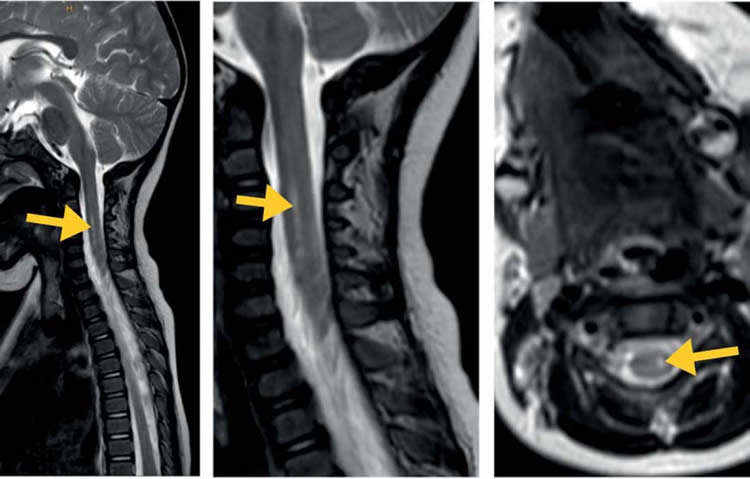Summary: A new study reviews the cases of two children who presented polio-like symptoms in Germany during the summer of 2016. Similar cases have been reported in the US and numerous other countries over the past few years.
Source: Deutsches Ärzteblatt International.
In Germany in the summer and autumn of 2016, several cases of illness in children were observed that were accompanied by acute flaccid paralysis. For the entire year 2016, 16 of such polio-like cases were registered with the Robert Koch-Institute. In an article in the current issue of Deutsches Ärzteblatt International (Dtsch Arztebl Int 2017; 114: 550-6), Johannes Hübner et al. describe this disease on the basis of two case reports, in which the neurological symptoms ranged from flaccid paralysis of the arm to tetraplegia requiring intubation and ventilation.
In the children under study, the main characteristic was damage to the anterior horn of the spinal cord as confirmed on MRI or lesions as a sign of motor neuron injury as confirmed electrophysiologically. A pathogen could almost never be detected in cerebrospinal fluid, but epidemiological associations and confirmation of viruses from stool specimens or respiratory secretions pointed at enteroviruses as the likely pathogen. The prognosis of such polio-like disease with flaccid paralysis of differing severity cannot be estimated at the beginning–it ranges from hardly detectable impairment of the arm movement to care dependency in permanent severe symptoms. Targeted therapeutic measures are not available. No sufficient evidence currently exists for the effectiveness of corticosteroids, immunoglobulins, plasmapheresis, or antiviral medications.

The authors express concern that since 2012, several cases of severe flaccid paralysis have been observed in several countries, which closely resemble the symptoms of poliomyelitis, but which are caused be different pathogens that are often not identifiable. The term “acute flaccid paralysis with anterior myelitis” has been adopted, in order to distinguish the symptoms from those of classic poliomyelitis.
Source: Johannes Hübner – Deutsches Ärzteblatt International
Image Source: NeuroscienceNews.com image is credited to Institute for Diagnostic Imaging and Interventioanl Radiology, HELIOS-Klinkum-Hildersheim, Germany.
Original Research: Full open access research for “Acute Flaccid Myelitis in German Children in 2016—the Return of Polio?” by Hübner, J; Kruse, B; Christen, H; Weidenmann, J; Weiner, V; Schöne-Bake, J; Eichinger, A; Diedrich, S; and Müller-Felber, W in Deutsches Ärzteblatt International. Published online September 2017 doi:10.3238/arztebl.2017.0551
[cbtabs][cbtab title=”MLA”]Deutsches Ärzteblatt International “Polio-Like Disease in Children.” NeuroscienceNews. NeuroscienceNews, 8 September 2017.
<https://neurosciencenews.com/children-polio-7440/>.[/cbtab][cbtab title=”APA”]Deutsches Ärzteblatt International (2017, September 8). Polio-Like Disease in Children. NeuroscienceNew. Retrieved September 8, 2017 from https://neurosciencenews.com/children-polio-7440/[/cbtab][cbtab title=”Chicago”]Deutsches Ärzteblatt International “Polio-Like Disease in Children.” https://neurosciencenews.com/children-polio-7440/ (accessed September 8, 2017).[/cbtab][/cbtabs]
Abstract
Acute Flaccid Myelitis in German Children in 2016—the Return of Polio?
Background: Although poliomyelitis has almost been eradicated worldwide, cases of a polio-like disease with asymmetrical flaccid paralysis of variable severity have been seen repeatedly in recent years.
Methods: Data were collected on children treated in hospitals in the German federal states of Bavaria and Lower Saxony in 2016. The frequency of disease across Germany was estimated on the basis of voluntary reporting to the Robert Koch Institute. 16 cases were registered there for the entire year 2016.
Results: 7 children with flaccid paralysis of acute onset were treated in the participating hospitals in the summer and fall of 2016. We describe two illustrative cases, one with a mild course and one with a severe course. Rapid diagnosis requires not only clinical neurological assessment but also neurophysiological studies, magnetic resonance imaging (MRI), and targeted microbiological testing. The characteristic features include damage to the anterior horn of the spinal cord that can be seen on MRI and/or electrophysiologically demonstrable abnormalities indicating motor neuron damage. A pathogen can hardly ever be identified in the cerebrospinal fluid, but the epidemiological context and the detection of viruses in the stool or respiratory secretions indicate that enteroviruses may be responsible.
Conclusion: The prognosis of this disease cannot be reliably assessed at first, and no specific treatment is currently available.
“Acute Flaccid Myelitis in German Children in 2016—the Return of Polio?” by Hübner, J; Kruse, B; Christen, H; Weidenmann, J; Weiner, V; Schöne-Bake, J; Eichinger, A; Diedrich, S; and Müller-Felber, W in Deutsches Ärzteblatt International. Published online September 2017 doi:10.3238/arztebl.2017.0551







